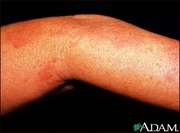The human herpesviruses include at least eight distinct DNA viruses, including herpes simplex virus type 1, herpes simplex virus type 2, varicella-zoster virus, cytomegalovirus, Epstein-Barr virus and three newly described human herpesviruses, types 6, 7 and 8. Erlich reviews the clinical course and management of herpesvirus infections.
All of the viruses cause latent infection and can result in recurrent clinical infections through reactivation. Initial infections and recurrent infections with herpes simplex virus and varicella-zoster virus are commonly seen in the clinical setting. Herpes simplex virus types 1 and 2 infect mucous membranes and skin surfaces, causing latent infections in the corresponding sensory nerve ganglia. The initial infection may be asymptomatic or may cause painful vesicles that crust and then heal by epithelialization within two to three weeks. The frequency of recurrence varies and generally is less severe than the initial episode. Asymptomatic shedding can occur even when no lesions are visible.
Usually the diagnosis of herpes simplex virus is made clinically, but viral cultures and the visualization of infected cells by direct fluorescent antibody stain are the most reliable tests. Serologic testing is unreliable.
Treatment of first-episode herpes simplex virus infection is acyclovir, 200 mg five times daily for 10 days. Recurrence can be managed with acyclovir, 200 mg five times daily, 400 mg three times daily, or 800 mg twice daily. Treatment should continue until all lesions are fully crusted, which usually takes about five days. Patients should be encouraged to begin treatment with prodromal signs. Topical treatment is not effective. Patients with frequent recurrences (more than six episodes annually) may benefit from suppressive therapy with acyclovir, 200 mg three times daily or 400 mg twice daily. Acyclovir appears to be equally effective for the management of herpes simplex virus at any anatomic site. Two newer drugs have been approved for the treatment of recurrent herpes, famciclovir in a dose of 250 mg twice daily and valacyclovir in a dose of 500 mg twice daily. Valacyclovir, 1 g twice daily, has also been approved for the treatment of a first episode of herpes simplex virus infection.
Varicella-zoster virus, which causes chickenpox and zoster (shingles), can produce severe illness in adults, with primary infections resulting in pneumonia and recurrent infections causing debilitating skin rashes. The diagnosis of varicella-zoster virus is most often made by clinical examination. Viral cultures are less useful because varicella-zoster virus grows slowly and unreliably in the laboratory. Serologic testing is useful to determine past infection but is not helpful in the treatment of the first episode.
Treatment of varicella-zoster virus infection includes a regimen of acyclovir, 800 mg five times daily for seven days in adults or a suspension of 20 mg per kg four times daily for five days in children, for chickenpox. Treatment should be started within 24 hours of the onset of rash to be most effective. Symptoms may be shortened in patients with zoster by the use of acyclovir, 800 mg orally five times daily, famciclovir, 500 mg three times daily, or valacyclovir, 1 g three times daily for seven days. Treatment is most effective in elderly patients as this population is most at risk of developing postherpetic neuralgia. These newer agents appear to be superior to acyclovir for this indication. Valacyclovir should not be administered to patients with advanced human immunodeficiency virus disease, bone marrow transplant or kidney transplant because of episodes of thrombotic thrombocytopenic purpura and hemolytic-uremic syndrome that have occurred during initial trials using high doses. Treatment regimens that combine the use of corticosteroids with an antiviral agent may reduce acute pain in older patients, but corticosteroids should not be used alone because of the risk of steroid-induced immunosuppression.
A vaccine that reduces the risk of varicella-zoster infection is available and appears to be effective in preventing varicella following exposure. Children one through 12 years of age receive 0.5 mL subcutaneously, and persons more than 12 years of age should receive two subcutaneous doses of vaccine (0.5 mL) given one to two months apart. Older patients with uncertain histories should be screened serologically for immunity before vaccination.
The authors conclude that vaccine recipients are at risk for developing zoster because of the presence of attenuated live virus material. The duration of protection is uncertain, and boosters may be necessary.
Erlich KS. Management of herpes simplex and varicellazoster virus infections. West J Med 1997;166:211-5.
COPYRIGHT 1997 American Academy of Family Physicians
COPYRIGHT 2004 Gale Group



